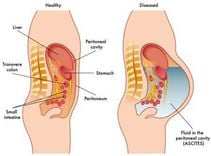This is an automatically translated article.
Posted by Master, Doctor Mai Vien Phuong - Department of Examination & Internal Medicine - Vinmec Central Park International General HospitalEssential fatty acid deficiency is rare in healthy adults and children who have a varied diet with adequate amounts of essential fatty acids, linoleic acid (LA) and alpha-linolenic acid (linoleic acid). Clinicians should be aware of the risk of essential fatty acid deficiency in specific populations that may have malabsorption syndromes, or for other reasons that severely limit fat intake, absorption absorption or transformation.
1. The role of fat in the body
Fat is an essential dietary component, whether it is part of a diet, an enteral nutritional formula or part of an parenteral nutritional supplement. The human body needs fat stores to cushion organs and provide insulation to regulate temperature. Fat stores can be used for energy during times of starvation, although it is important to realize that some tissues in the body (brain and red blood cells) rely solely on glucose for energy. because fat cannot be metabolized to make glucose.Dietary fat is not only a source of energy through oxidation, it is also necessary to facilitate the absorption of fat-soluble vitamins in the small intestine.
Fat is important at the cellular level as it is an essential part of cell membranes. Cell membranes are composed of phospholipids, which are sensitive to chemical signals. Consuming different types of fats (e.g. omega-3 fatty acids versus omega-6 fatty acids) will allow different types of fats to be incorporated into cell membranes, modulating responses to a number of processes. Metabolism includes inflammation, the control of gene expression in cells, and the production of cellular proteins. A recent review by Calder provides a more detailed discussion of these processes.
2. Clinical manifestations of essential fatty acid deficiency
Patients with essential fatty acid deficiency may have evidence of both physical and biochemical deficiency. For patients with known risk factors, clinicians should monitor for evidence of essential fatty acid deficiency.There are nonspecific biochemical changes that should suspect essential fatty acid deficiency in patients at risk. Richardson and Sgoutas followed four patients receiving parenteral nutrition and found increases in serum aspartate transaminase (AST), alanine transaminase (ALT) and lactate dehydrogenase, paralleling an increase in the triene ratio: Tetraene with fat-free parenteral nutrition time. The authors noted a similar pattern with serum triglyceride concentrations. All improved with the addition of an infusion lipid emulsion. Changes in liver function tests are thought to be due to mitochondrial dysfunction that occurs with essential fatty acid deficiency. Many studies have documented that essential fatty acid deficiency has altered platelet aggregation.

3. Skin manifestations of essential fatty acid deficiency
Physical manifestations of essential fatty acid deficiency often appear on the skin. A close examination of the skin can reveal many nutritional deficiencies, including vitamin B, vitamin C, and zinc, as well as essential fatty acid deficiencies. Much of what is known about the physical manifestations of essential fatty acid deficiency comes from early case reports in the 1970s and 1980s. The patient complained of a dry, scaly rash, which also had underlying disease. associated with fat malabsorption, should raise clinical concerns about essential fatty acid deficiency and prompt further investigation. It is important to realize that zinc deficiency can also manifest as a dry, scaly rash and that patients with malabsorption and chronic diarrhea may have both essential fatty acid deficiency and zinc deficiency.4. Treatment of essential fatty acid deficiency
If essential fatty acid deficiency is identified, the clinician must first consider the cause. For patients on the diet, review the dietary history carefully and determine the level of essential fatty acid supplementation.Advise patients with fat malabsorption to consume foods rich in essential fatty acids, including condiments made from oils high in essential fatty acids, such as mayonnaise and margarine. with soybean oil, and powders such as sunflower seed butter. For those with pancreatic insufficiency, assess the appropriateness of pancreatic enzyme replacement.
5. Dosage to help determine the amount of lipid emulsion infusion
For patients who are dependent on parenteral nutrition, recalculate the fat content of the parenteral nutrition prescription and determine the amount of linoleic acid being given. Although 100g of soybean oil lipid emulsion infusion per week is sufficient to prevent essential fatty acid deficiency, patients may need more to treat pre-existing essential fatty acid deficiency. Unfortunately, there are no dosage guidelines to help determine the amount of infusion lipid emulsions. If the patient is getting only 4% calories from linoleic acid, the clinician may consider increasing 6% calories from linoleic acid for a defined period of time (eg, 2-4 weeks) and then testing. the ratio of triene:tetraene. Patients who are dependent on parenteral nutrition may also be at risk for carnitine deficiency and should be evaluated and treated if deficient.6. The role of tropical vegetable oil
Tropical vegetable oils such as: Coconut, palm kernel or palm oil. Like all fats and oils, these three oils contain many different types of fatty acids, but unlike other vegetable oils, they contain a lot of saturated fatty acids. Coconut oil is 92%, palm kernel oil 82% and palm oil 50% saturated fat. These oils are found in commercial cakes, cookies and "snacks".For patients who are dependent on parenteral nutrition, who cannot reliably receive infusion lipid emulsions (eg, patients with severe hypertriglyceridemia), tropical oils have can be a source of essential fats. Using tropical vegetable oils to treat essential fatty acid deficiency may be worth trying, but the clinician must recognize that this approach may not be effective. In some cases, providing an infusion lipid emulsion (particularly for patients who must follow an extremely low-fat diet, e.g., those with chyle leak) is the best way to manage essential fatty acid deficiency.

7. Follow up
There are few data to guide monitoring of essential fatty acid status. Standard follow-up practice for patients on long-term M.D. parenteral nutrition suggests checking the fatty acid panel at least once or twice per year. Clinicians may wish to monitor at-risk patients more closely, eg every 3 to 4 months. Clinicians must maintain a high level of suspicion for essential fatty acid deficiency in at-risk patients and should monitor physical signs of deficiency so that biochemical evaluation can be rapid. For patients requiring prolonged fat restriction, conduct a careful physical examination first to evaluate for signs or symptoms of essential fatty acid deficiency. Check the triene:tetraene ratio if there is concern about essential fatty acid deficiency or if the patient is malnourished. If there is no concern for essential fatty acid deficiency at initial clinical assessment, check the triene:tetraene ratio after four weeks of extreme fat restriction.CONCLUSION
At-risk patients should be closely monitored for signs and symptoms of essential fatty acid deficiency because biochemical changes suggestive of essential fatty acid deficiency occur before clinical signs and symptoms occur. ready to appear.If you have a need for consultation and examination at Vinmec Hospitals under the national health system, please book an appointment on the website (vinmec.com) for service.
Please dial HOTLINE for more information or register for an appointment HERE. Download MyVinmec app to make appointments faster and to manage your bookings easily.
ReferencesKris M. Mogensen, Essential Fatty Acid Deficiency, Nutrition issues in gastroenterology, series
164, Practicalgastro. Chan LN. Iatrogenic malnutrition: a serious public health issue caused by drug shortages. JPEN J Parenter Enteral Nutr. 2013;37:702-704. Jones PHJ, Rideout T. Lipids, sterols, and their metabolites. In: Ross AC, Caballero B, Cousins RJ, Tucker KL, Ziegler TR. Modern Nutrition in Health and Disease. Lippincott, Williams and Wilkins. Philadelphia, PA. 2014;65-87. Calder PC. Functional roles of fatty acids and their effects on human health. JPEN J Parenter Enteral Nutr. 2015;39:18S-39S. Tappenden KA. Intake: digestion, absorption, transportation, and excretion of nutrients. Print: Mahan LK, Raymond JL. Krause's Food & the Nutrition Care Process, 14th Edition. Elsevier. St. Louis, Missouri. 2017:2-16. Hamilton C, Austin T, Seidner DL. Essential fatty acid deficiency in human adults during parenteral nutrition. Nutr Clin Pract. 2006;21:387-394














